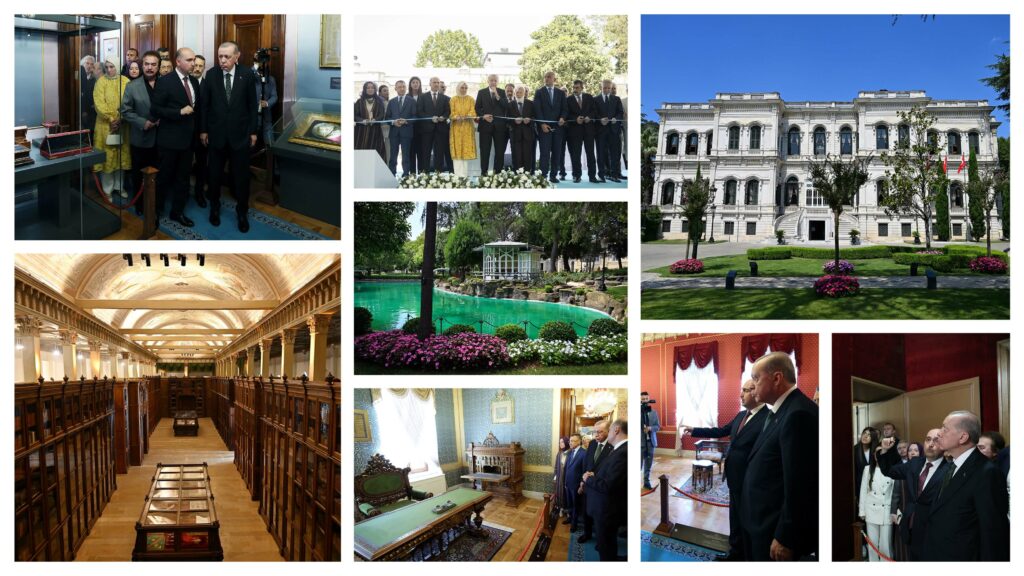Turkish President Recep Tayyip Erdoğan opened the restored Yıldız Palace, the former residence of the last absolute Ottoman monarch, Sultan Abdulhamid II, in a ceremony in İstanbul on Friday, saying the revitalized palace will boost the city’s historical and cultural appeal.
Erdoğan addressed a crowd at the opening ceremony, expressing his pleasure in reopening one of Istanbul’s most significant historic sites. “Today, we gather to unveil one of the most beautiful historic treasures of our beloved Istanbul, a city where loving even a single neighborhood is worth a lifetime,” he said.
The Yıldız Palace, restored under the supervision of the Turkish government, has undergone six years of restoration and landscaping work.
“The Yıldız Palace, a symbol of our city, now opens its doors to our people and visitors from around the world. I hope this precious gift from our ancestors brings joy to our nation,” Erdoğan said.
The palace is closely associated with Sultan Abdulhamid II, the last absolute monarch of the Ottoman Empire.
Abdulhamid II, born on September 21, 1842, was the 34th sultan of the Ottoman Empire and the last to exert effective control over the fracturing state. His reign, from 1876 to 1909, was marked by significant political and social turbulence, including the loss of significant territories and a war with the Russian Empire.
Elevated to power following the deposing of his brother Murad V, Abdulhamid initially showed progressive tendencies by promulgating the empire’s first constitution in 1876. However, he soon suspended the constitution and ruled as an absolute monarch for three decades.
Abdulhamid’s reign saw the continuation of Ottoman modernization efforts, including extensive reforms in education and infrastructure, such as the construction of railways and telegraph systems. He also emphasized Pan-Islamism, attempting to unite Muslims under Ottoman leadership. His reign was marred by internal dissent and external pressures, leading to his eventual deposition during the Young Turk Revolution in 1909. Abdulhamid spent his final years in relative obscurity, passing away on February 10, 1918. His legacy remains controversial, with his supporters viewing him as a defender of Islam and his detractors condemning his autocratic rule.
He is a beloved figure for Turkey’s Islamists and nationalists and a hated one for leftists, who view him as a symbol of the oppressive ancien régime.
Erdoğan highlighted the palace’s historic significance, noting that it served as the administrative center during some of the Ottoman Empire’s most tumultuous years.
“With its unique architectural and artistic features, the Yıldız Palace witnessed the most critical moments of the Ottoman Empire,” Erdoğan said. “It became a symbol of resistance against attempts to dismantle the state.”
The palace, originally a series of pavilions built by Sultan Selim III in the early 19th century, gained prominence when Sultan Abdulhamid II moved his court there from Dolmabahçe Palace. “Abdulhamid II, described by [poet] Necip Fazıl as perhaps the greatest among 36 Ottoman rulers, ruled the state from here for 33 years until the 1909 coup,” Erdoğan said.
Erdoğan also mentioned the palace’s role in Turkish national history, recalling the meeting between Turkey’s founding father, Mustafa Kemal Atatürk, and the last Ottoman sultan, Mehmed VI, before Atatürk’s departure for Samsun, which marked the beginning of the Turkish War of Independence.
Despite its historical importance, the palace suffered neglect and misuse over the years, including being used as a casino in the 1920s. Erdoğan condemned this treatment, emphasizing the importance of preserving the nation’s heritage. “While some countries meticulously preserve their 100 to 150-year-old historic assets, we failed to protect many of our cultural treasures,” he said.
Erdoğan concluded his speech by expressing his hope that the restored palace would serve as a source of pride for the Turkish people and a valuable educational resource for future generations. “By reopening the Yıldız Palace, we have not only restored its stones, walls, and furnishings but also revived its historical identity,” he said. He announced that the palace would be open to the public free of charge until the end of the following month.
After the speech İstanbul’s chief mufti, Prof. Dr. Safi Arpaguş, led a prayer, and Erdoğan, along with other dignitaries, cut the ribbon to officially open the palace to the public.
The ceremony was attended by several high-profile officials and guests, including Minister of Culture and Tourism Mehmet Nuri Ersoy, Minister of Education Yusuf Tekin and Presidential Communications Director Fahrettin Altun.
According to critics the legacy of Abdulhamid II is marred by brutal oppression of ethnic minorities and relentless authoritarianism, and it stands in sharp contrast to modern democratic ideals and human rights. They view Erdoğan’s glorification of Abdulhamid through media and speeches as a troubling alignment with a past marked by tyranny.

